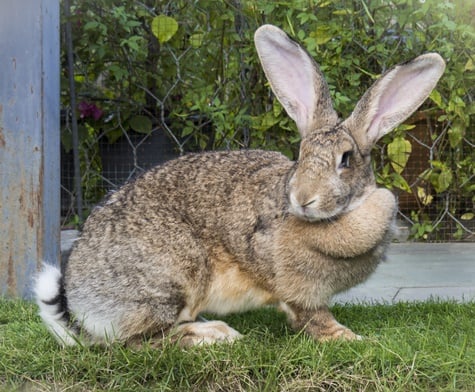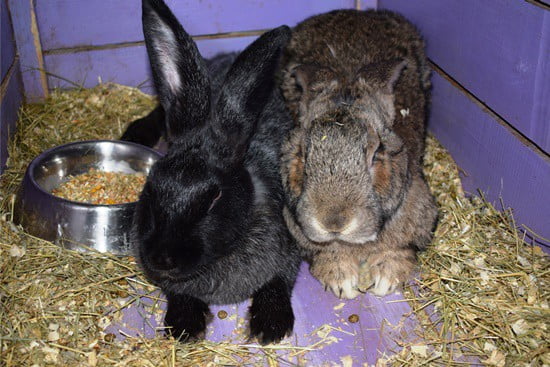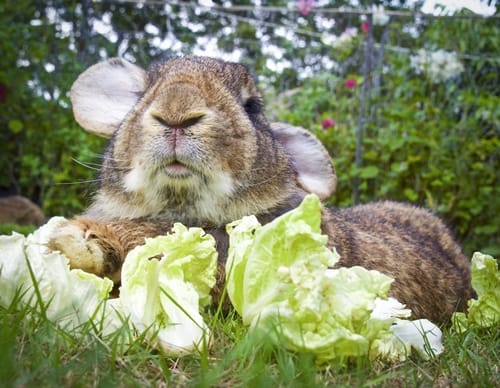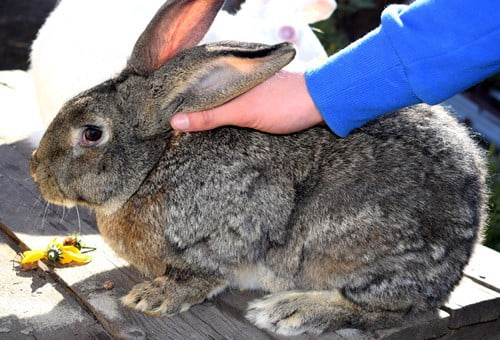Flemish Giant rabbits are much bigger than your average-sized rabbit. They may look a bit strange at first glance, but Flemish Giants are easy to fall in love with as pets.
Giant rabbits have the same basic needs as smaller rabbits. Flemish Giant rabbits need more food, living space, and attention than regular-sized rabbits. They may also need more veterinary care.
Although they are friendly, they can become aggressive if mishandled. Also, if not looked after properly, they are prone to sore hocks, obesity, and rabbit snuffles.
How to Care for a Flemish Giant Rabbit
If you plan to adopt a Flemish Giant, you should be aware of the following:
- Living Space Requirements – Standard rabbit hutches are not big enough for Flemish Giant rabbits. We’ll show you what type of living spaces are suitable for giant rabbits.
- Food Requirements – Giant rabbits don’t have any unique dietary requirements. But they do eat a lot more food than standard-sized rabbits.
- Grooming – Although they are not long-haired, Flemish Giants need to be groomed weekly.
- Handling a Flemish Giant – Most rabbits hate being handled, but this is especially true with giants. You will need to know how to handle a giant rabbit safely.
- Preventing Disease – Some illnesses and diseases are more prevalent in giant breeds. We’ll show you how these diseases can be prevented.
As long as you have the right resources to hand, caring for a giant rabbit is not too difficult.
What is a Flemish Giant Rabbit?
Flemish Giant rabbits are bigger than your average-sized dog. At first glance, Flemish Giants might look a bit scary, but they are just as adorable as regular-sized rabbits. In fact, these rabbits are often referred to as ‘gentle giants.’
Flemish Giant rabbits were first discovered in Belgium in the 16th Century. Locals started to breed these rabbits, and some were exported to England in the mid-19th Century.
Soon after, they made their way to America. In fact, the Flemish Giant is the ancestor of many of the pet rabbits we have in our homes today.
Flemish rabbits were originally bred for fur and meat. But, nowadays, they are mostly kept as pets. They are docile, intelligent, and friendly – as long as they are kept in the right conditions.

Flemish Giant Rabbit Characteristics
Besides being larger than your average-sized rabbit, Flemish Giants have the following characteristics
- A broad body with a heavy bone structure
- Flemish Giants in the U.S. tend to have a semi-arched back, while Flemish rabbits in Britain tend to have a flatter back
- Thick and glossy fur (with a dense undercoat)
- Males have larger heads and females have a dewlap
- When you stroke the rabbit, there will be a roll-back effect with the fur
- Long ears
- Bold, endearing eyes
- Seven different colors – Black, blue, Fawn, Light Gray, Steel Gray, White and Sandy
- A lifespan of 4-6 years – some Flemish Giants have lived beyond 8 years, but this is rare
The Personality of the Flemish Giant
Flemish giants have very special personalities. They are intelligent, docile, and sociable. In fact, they will often seek out human interaction. It’s not unusual for Flemish Giants to greet their owners in the following ways:
- Stand up of their hind legs as if to say, ‘look at me!’
- Nudge you with their nose, as if asking for attention
- They may even bring their toys to you in the same way a dog does
- Hop over to you and sit beside you, as if to ask for a stroke
Flemish Giants are loyal and tend to pick one human as their favorite. If you are the chosen one then you are fortunate, as these rabbits are genuinely a joy to be around.
For sociable personality traits to become fully developed, they must be handled as kittens.
Although super-friendly, Flemish Giants can cause injury if they suddenly feel threatened. Giant rabbits do not like being handled and will often thrash their feet or bite if they are handled inappropriately.
Flemish Giants may also bite if they are stroked for too long, or if they feel unable to escape from a situation. They can also become very vocal if they feel unhappy or stressed.
This needn’t be concerning if you reduce stress in the household and don’t try to handle your rabbit unnecessarily. Young children should also be taught how to interact with one to avoid injury.
How Big Do Flemish Rabbits Get?
According to the Guinness World Records, the longest Flemish Giant rabbit was 4 foot 3 inches (1.3 meters) long.
However, this is quite unusual. The average Flemish is 2.5-3.0 feet long (76cm – 91cm). Even so, this is still longer than many dogs.
What is the Average Weight of a Flemish Giant Rabbit?
According to PDSA, the average Flemish Giant weighs about 7kg (15 lbs.). That’s the same weight as 3 Chihuahua dogs. Males tend to be heavier than females.
Show-worthy Flemish Giant rabbits weigh approx. 10 kg (22 lbs.). That’s the same weight as 2 gallons of paint.

Giant Rabbit Comparison
Flemish rabbits are not the only type of giant rabbit. There are at least 6 breeds of giant Rabbit. Below, you can get a sense of how large Flemish Giants are in comparison to other oversized rabbits.
| Giant Rabbit Breed | Average Weight in kg | Average Weight in Lbs. |
|---|---|---|
| Belgian Hare | 2.7 – 4.5 | 6 –10 |
| New Zealand White | 4 – 5 | 9 – 12 |
| French Lop | 4.5 – 6.8 | 10 – 15 |
| English Lop | 5.5 – 6.8 | 12 – 15 |
| Flemish Giant | 6.5 – 7 | 15 |
| Continental Giant | 7 – 8 | 15 – 17 |
To put this into perspective, the average weight of a domestic rabbit is 1kg. So, a Flemish Giant is around 6 times the size of your average rabbit.
Do Flemish Giants Need to be Cared for Differently?
Giant rabbits have similar needs to smaller rabbits, but there are some important differences.
As you’d imagine, giant rabbits eat a lot more food than smaller rabbits. They also need more grooming and attention than most smaller rabbits. However, the main difference between giant and regular-sized rabbits is the amount of space they need.
How Much Space do Flemish Giant Rabbits Need?
Flemish Giant rabbits need plenty of space to move around, so the average rabbit hutch won’t be sufficient. And, just like all rabbits, Flemish Giants need a bonding partner, so you should ideally have the space to accommodate 2 rabbits.
According to Rabbit Welfare, a rabbit should be able to make at least 3 consecutive jumps within the enclosure. For a rough estimate of the space needed, multiply your rabbit’s body length by 4. So, if your Flemish Giant is 2.5 feet long, you will need an enclosure that is at least 10 feet in length.
Also, rabbits should be able to lay (comfortably) outstretched width-ways across their enclosure. If your rabbit is 2.5 feet long, aim for a width of 4 feet.
In addition, Flemish Giants often stand on their hind legs, so the enclosure needs to be at least as tall as your rabbit stretched out (plus a bit more). So, the average Giant Flemish would need a cage that is at least 4 feet tall.
Taking this into account, the minimum enclosure size would be 10 x 4 x 4 feet (3 x 1.2 x 1.2 m). Even so, this size of enclosure would be the bare minimum, so it’s best to provide your rabbit(s) with more space if you can.
Flemish Rabbit Enclosures
The average rabbit hutch is nowhere near 10 feet in length. So, when housing a giant rabbit, you’ll need to think creatively. Giant rabbits can be accommodated in the following ways:
- A Converted Shed – Most medium-sized sheds will be large enough to accommodate 2 giant rabbits. You will need to ensure the shed is secure. Ideally, attach a run to the shed so your rabbits can explore the garden.
- An Aviary – Large bird enclosures are ideal for giant rabbits. If keeping your rabbits outdoors in this type of enclosure, you will need to build suitable fencing to keep predators away.
- Dog Cages – Larger dog cages can be suitable for giant rabbits. It’s important to cover wire flooring with a solid mat and soft bedding, as giant rabbits can easily get sore hocks.
- An Indoor Room – Often, keeping a giant rabbit in one room in the house is the best solution. You should ensure there is no electrical wiring in the room, and block access to the rest of the house.
Rooms, sheds, and aviaries are more suitable than dog cages for bonded pairs. This is because they allow enough space for the rabbits to be sociable, but also enjoy some alone time when necessary.
Indoors vs Outdoors
Flemish Giants can live indoors or outdoors. If you keep them indoors, make sure the temperature does not exceed 90 degrees Fahrenheit. Also, avoid keeping them in humid conditions. Some people keep rabbits in their laundry room, but this is a bad idea because this is a very humid part of the house.
If you keep your rabbits outdoors, make sure predators cannot enter your garden. Also, avoid placing the rabbits somewhere very public. If neighbors can peer into your garden, this might frighten the rabbits.
Bedding Requirements
Due to their size, giants are prone to sore hocks. This means wire floors are not suitable for giant rabbits. If you are repurposing a dog cage (or another type of cage with a wire floor), this should be covered with resting pads, and then a layer of bedding.
So, which bedding is best for giant rabbits? Well, hay is one of the preferred substrates for rabbits. Your rabbit will love the warmth of a hay bed.
If your rabbit lives indoors, you might be reluctant to use hay because of the mess it will create. In this case, you could use blankets/carpet as the main form of bedding, and just use hay in a small corner of the room. Hay can be placed on top of a rubber mat to prevent damage to the carpets or flooring.
Litter Tray Bedding for Flemish Rabbits
Thankfully, because Flemish Giants have a very amenable personality, they are usually quite easy to litter train. But, for litter training to be effective, you need to select the correct litter.
You should avoid any type of crystal litter as this can be very sharp on rabbits’ feet. The best types of litter are:
- Paper-based Pellets – These are great for absorbing odor.
- Hardwood Stove Pellets – These are an affordable and absorbent option.
Cleaning up After a Flemish Giant Rabbit
As is the case with all rabbits, Flemish Giants require some cleaning. Cleaning up after rabbit pee and poop will be one of the biggest tasks.
If you’ve only ever owned a small rabbit, you’ll notice that Flemish rabbit poops are much larger. Some first-time owners are worried when they see this, but it is normal.
As always, make sure you clear the litter pan daily and disinfect the enclosure regularly.
As giant rabbits get older, they are prone to arthritis. This means they are less mobile and can develop urine-stained fur if steps are not taken to prevent this. Urine-soaked fur can be prevented and treated quite easily.
Grooming Requirements
Flemish giants don’t require a huge amount of grooming, but you will need to give them a helping hand from time-to-time. Set aside 20 – 30 minutes per week to groom your rabbit.
Flemish Giants have very dense fur. If too much fur is ingested, this can cause (or aggravate) a condition called GI stasis. This is very serious and should be actively prevented.
If nothing else, Flemish rabbits tend to enjoy being gently brushed. So, grooming can also become a bonding experience.
Grooming Tools for Giant Rabbits
It is important to groom your rabbit gently, using the correct tools. The most useful tools are:
- A Soft Brush – Being brushed with a soft brush is enjoyable and relaxing for rabbits. In many cases, it is strong enough to dislodge loose fur and check on the condition of your rabbit’s fur.
- Rubber Brushes – Rubber brushes are ideal for dislodging hair during malting season. Rabbits shed their coats during spring and fall.
- A Slicker Brush – This is great for detangling and accessing the dense undercoat, but it must be used gently.
- Flea Comb – This can remove fleas, flea eggs and stubborn bits of dirt from a rabbit’s fur. Again, it must be used very gently.
What to Feed a Flemish Giant Rabbit
When it comes to diet, Flemish Giants don’t require any special vitamins and minerals. They eat the same food as regular rabbits, just much more of it.
All rabbits require an unlimited supply of water and grass hay (ideally Timothy Hay). Bear in mind that giant rabbits will eat much more hay than small rabbits, so you’ll need to budget for this.
Whereas a normal-sized rabbit would eat 1-2 handfuls of greens per day, a Flemish Giant will eat 3-5 handfuls.
According to RSPCA, the average rabbit would eat 1-2 egg cups (25g – 50g) of high-fiber pellets per day. In contrast, a giant rabbit can eat 5-7 egg cups per day. This should be monitored closely and reduced if the rabbit puts on too much weight.
Unlike other rabbits, Flemish Giants do not reach maturity until they are 1.5 years old. So, some vets recommend feeding them more than 5-7 egg cups of pellets until they reach maturity.
On the other hand, some vets say this is not necessary as it may lead to obesity. Speak to a rabbit-savvy vet if you would like advice on nutrition for juvenile rabbits.

How to Entertain a Flemish Giant Rabbit
Giant Flemish rabbits are intelligent. If you are going to keep one as a pet, you’ll need to provide multiple sources of enrichment.
One of the kindest ways to do this is to provide a large enclosure. This will give your rabbit enough space to express their natural behavior. In addition, try the following:
Tunnels and Boxes
Most rabbits love tunnels, and Flemish Giants are no exceptions. It may be quite hard to find a suitable tunnel, but there are some possibilities. For example, children’s play tunnels or dog tunnels can work very well. Your rabbit may also appreciate old cardboard boxes.
Going Outdoors
Try to let your rabbit outdoors in a run. Your bunny will thank you for it! If you are in a country where Myxomatosis and mosquitos are prevalent (i.e. Australia) you might want to cover the run with a mosquito net.
Make Food Interesting
Vary the green veg and herbs you give to your rabbit. Though, make sure you don’t feed your rabbit anything toxic. Brussel sprouts and apple pieces (without the pips) are good treats for rabbits. Some rabbits enjoy searching for their food, so ‘hide’ it in new places. This can help to prevent boredom.
Bonding Partner
All rabbits, including Flemish Giants, need at least one rabbit friend. If you deny your rabbit a partner, they may become lonely and stressed.
Stress is linked to a multitude of health problems so it should be avoided at all costs. You can bond different sized bunnies as long as there is not a huge size difference. So, a Flemish Giant with a could be bonded with a Belgian Hare, but not a Dwarf rabbit.
Human Interaction
If Flemish rabbits are handled as kittens, they’ll enjoy human interaction throughout their lifetime. So, make sure you interact with your rabbit a couple of times a day. It’s best to go down to your rabbit’s level rather than try to pick your rabbit it.
Handling of a Flemish Giant
Most Flemish Giants hate to be handled, so don’t attempt to handle your bunny unless absolutely necessary. These rabbits have strong hind legs which can cause severe injury if they kick you. Also, Flemish Giants won’t hesitate to bite you if they feel threatened.
There are a few cases where it may be necessary to handle a giant bunny. For those times, here are some tips to remember:
- Do not allow a child to lift a giant rabbit.
- If possible, wait for your rabbit to approach you and pet them for a while before attempting to lift them.
- Rabbits have very delicate backbones so they must be supported during lifting. It’s important to be swift and firm but to use the minimum level of restraint possible.
- Only attempt to lift your rabbit from ground level.
- Proper Technique – When lifting a giant rabbit, start by placing both hands under your rabbit’s mid-section. As you lift the rabbit, keep one hand under the mid-section, and slide one hand down so it’s supporting the rabbits bottom. Then, left the rabbit up so that their head is resting on your shoulder. One arm should be snuggly support the rabbit around the mid-section and the other arm should be supporting their bottom.
Lifting a Flemish Giant rabbit can be difficult. If you don’t feel confident, ask your vet to show you how to do this properly.
Common Diseases in Flemish Giant Rabbits
Research suggests that Flemish Giant rabbits are susceptible to the following health problems:
- Sore Hocks (Pododermatitis) – Because these rabbits are very heavy, the weight can press against their feet and cause sore hocks. This is only usually an issue if the floor of their enclosure is made from wire mesh.
- Arthritis and Spondylosis – As your rabbit gets older, monitor their mobility. If they are unable to clean themselves, they may require pain medication.
- Rabbit Snuffles (P.Multocida) – Multocida is the bacteria responsible for rabbit snuffles. According to Sage Pub, P.Multocida causes a more severe reaction in Flemish Giants compared to New Zealand Giants. This suggests Flemish Giants may be particularly susceptible to rabbit snuffles.
- Heart Problems like Cardiomyopathy – It’s important to monitor your rabbit’s breathing – especially as they grow older.
- Obesity – Giant rabbits are more likely to be overweight than regular-sized rabbits. This could be because some owners don’t recognize how much space giant rabbits need for proper exercise.
Where Can I Get a Flemish Rabbit?
If you want to buy a Flemish Giant Rabbit, the National Federation of Flemish Giant Rabbit Breeders is a good place to start. On the NFFGRB website, you can find a list of approved breeders.
A Google search will also reveal local breeders in your area. Check reviews/testimonials and look at the breeder’s credentials before making a purchase.
Questions to Ask
When choosing a Flemish Giant rabbit here are some questions you may want to ask the breeder:
- Is this rabbit pure Flemish?
- What personality traits does the rabbit have?
- How big are the mum and dad? Can I see them?
- Are there any health problems or genetic defects I should be aware of?
- How old is this rabbit? Usually, kittens should not leave their mothers until they are at least 8 weeks. In the case of Giant Flemish rabbits, kittens should be left with their mother for a slightly longer period (at least 10 weeks). This is because giant rabbits take longer to reach maturity.
Some rabbit breeders will also provide an illness warranty for a set period of months.
How Much Does a Flemish Giant Cost?
Flemish Giants start at $30 – $60. If you are looking for a particularly large or show-quality Flemish, this will cost in the region of $250 – $300.
It’s important to factor in the ongoing costs of these rabbits, too. The average cost of owning a bunny is $600 – $1200 per year. A giant rabbit probably costs closer to the $1200 mark.
Is the Flemish Giant Right for Me?
Flemish giants are sociable, docile, and intelligent creatures. In many ways, they are the perfect pet. But owning a giant rabbit is quite a responsibility. Before adopting a Flemish Giant, consider the following:
- Do you have space for a 10 x 4 x 4-foot pen, or a spare room in the house?
- Can you source plenty of hay, pellets, and green veg for your rabbit?
- Do you have the time to groom your rabbit at least once a week?
- Are you prepared for the vets’ bills of owning a rabbit?
- Can you give attention to your bunny each day?
- Is your family suited to a giant bunny? Giant bunnies make good pets for older children, but they might not be suited to families with very young children. This is because they can become easily stressed by noise and heavy handling.
If you can say yes to these questions, then it sounds like a Flemish Giant could be a great pet for you. On the other hand, if you can’t accommodate such a giant rabbit, you might consider a Belgian Hare or New Zealand White rabbit instead.


How often do flemish giants need to go to the vet? I am considering getting one and am doing a ton of research.
Also how much do the vet appointments typically cost?
Is there any such thing as a lion head giant bunny? I had a regular lion head bunny. He was so affectionate and treated me when I came home. He passed away due to an old age of 7 1/2. He was wonderful. I would like a giant bunny but also want a lion head bunny again. Please if you don’t know of any right now. Could you please be on the lookout for one or two for me please. Thank you I enjoyed ready about the giant bunnies.
My Flemish Giant died six months ago and I mourn for him every day. He had the run of the house and the shed and the yard but no partner bunny. He hopped downstairs nearly every night to sleep on a soft bench by my bed.